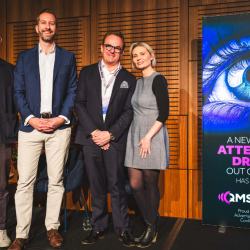Changing consumer trends and a plethora of channels appearing across the advertising environment is making it harder for brands to gain traction, as the average consumer is allegedly exposed to more than 10,000 ads daily. But the dilution of advertising and potential wastage should not be a concern. Brands and agencies that are singing a tune within the noise, are adopting innovative solutions to plug the gap between metric-based performance marketing and wider brand awareness to improve audience cut-through. From gathering and analysing first-party data and real-time campaign performance insights to generating personalised and engaging content, marketers across the globe are beginning to wake up to the potential of AI, with the marketing and sales forecast to extract approximately $460bn of value from the technology.
Yet despite its obvious selling points, marketers continue to grapple with how to effectively deploy the technology.
Ready, steady, online!
Online filled the void left by the prolonged pause on brick-and-mortar shopping during the pandemic. More than 60% of all shopping journeys now begin online — irrespective of whether the final purchase happens virtually or in-store.
Whilst this has incentivised brands to elevate their digital offerings, it has also been the cause of major fragmentation. This has seen consumer attention rise in the priorities ranking from an optional extra to a be-all and end-all. And with 52% of consumers wanting personalised experiences, now is the optimal time to cater to this expectation, across channels.
Emerging opportunities
In 2023, ad channels like DOOH, CTV, and in-game advertising gained traction, foreseeing significant growth in revenue. In-game ads were estimated to hit €2.86bn by year-end and are projected to reach €4.60bn by 2027 with a 12.62% annual growth rate. Integration of newer channels with traditional media emerged as a key trend, exemplified by the UK’s 9.5% CTV spending increase in 2023. Expectedly, investments in CTV, complementing linear TV efforts, will surge by 16.7% in 2024.
AI and machine learning offer a solution, sifting through vast internet content to pinpoint relevance with minimal input, like specific keywords. This technology’s precision and scalability transcend channel boundaries, becoming an indispensable tool for marketers. Brands benefit from AI’s ability to tailor highly targeted strategies, essential in reaching niche audiences.
According to McKinsey, Gen AI will contribute trillions to the global economy. In 2024, leveraging AI-powered tools becomes pivotal for marketers seeking optimisation. AI streamlines data analysis, uncovers actionable insights, and automates repetitive tasks, empowering more efficient campaign management. Programmatic advertising, coupled with AI, enhances precision in audience targeting. Europe’s programmatic ad market has doubled since 2017, set to reach $100bn by 2024 per Statista.
But first-party targeting isn’t everything.
All in the context
Creating relevant content that captures eyeballs and drives conversions is the bottom line. Targeting audiences based on website content as opposed to visitors’ personal information instantly negates the need to harvest user data through cookies — a powerful asset to have during a period when consumers are increasingly fearful about their personal information being leaked. StackAdapt identified that contextual ads can increase user engagement by 4-10 times. Harnessing AI-powered contextual targeting can be a brand’s way to target relevant audiences without relying on old-fashioned methods.
Major broadcasters such as Sky and ITV are already capitalising on this strategy — and this is a trend that we can expect to continue as we move into 2024.
Mastering AI
For brands and advertisers seeking greater confidence in leveraging AI, it’s crucial to prioritise the quality of input data. AI tools, when trained with high-quality data, can significantly enhance decision-making processes and streamline operations for agencies. When used efficiently, AI enables more efficient workflows and also opens avenues for real-time metrics and analytics.
Like with any system, mastering AI is akin to becoming a skilled chef — practice and testing is essential. Regular training of AI models enhances adaptability to traffic shifts and inventory changes, ensuring heightened accuracy. A/B testing remains pivotal in crafting a tailored strategy. AI can crunch 100s of billions of data sets, offering real-time feedback, and empowering brands with the data to refine campaigns swiftly across various channels. Machine learning optimises costs and optimises bidding to align with diverse campaign objectives.
Adaptability is crucial as market dynamics evolve. AI must adjust bidding strategies and ad frequency in response to shifting user behaviours on media platforms. Staying accurate demands continual AI adaptation to evolving market conditions.
Avoiding an advertising dumpster fire
Increased advertising saturation isn’t going anywhere — and the death of third-party cookies only serves to put advertisers more on edge. However, there’s no need for brands to spin their wheels uncontrollably — particularly with the tech-based solution already in our grasp. As we move forward, AI stands as a critical ally in navigating the complexities of modern advertising. Its ability to process vast amounts of data swiftly, identify niche targets, and adapt to evolving market conditions positions it as an indispensable resource for marketers.
The evolution and proactive integration of AI in advertising strategies pave the way for more precise, efficient, and impactful campaigns in 2024 and beyond.
Featured image: Niklas Liniger / Unsplash


























